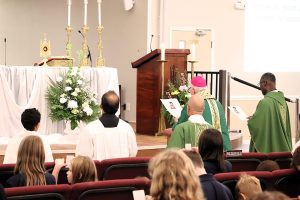Epiphany Cathedral in Venice has secured a first-class relic of Blessed Carlo Acutis, the first millennial saint.
Blessed Carlo Acutis was a young Italian teenager with a deep love for the Eucharist and an inspiring faith in God. Blessed Carlo was born in 1991 and dedicated his short life to spreading the devotion to the Eucharist, which he called the “highway to heaven.” Known for his exceptional skill with computers, Blessed Carlo created a website documenting Eucharistic miracles from around the world, using technology as a way to share his faith. He died from leukemia in 2006 when he was only 15.


The relic was obtained by Msgr. Patrick Dubois, Rector of Epiphany Cathedral, while he was on retreat in October and had the opportunity to pray at the Shrine of the Renunciation in Assisi, Italy, where Carlo Acutis’ body is permanently exposed.
“While there, I visited the Chancery and, as a means to continue in some way the Bishop Conference’s outreach last year for a greater Eucharistic Revival, and also, so as to enable our parishioners, our school children, and indeed, all the faithful who would visit Epiphany, I asked if our Cathedral in Venice could be given a first class relic of the soon to be canonized, Blessed Carlo Acutis,” Msgr. Dubois stated.
Thanks to the kindness and support of Most Reverend Domenico Sorrentino, the Archbishop of Assisi, the request was immediately granted, and Msgr. Dubois was elated to bring back with him the relic of Blessed Carlo Acutis.
Bishop Frank J. Dewane formally welcomed the relic to the Cathedral during a prayer service following a Mass for students at Epiphany Cathedral Catholic School on Nov. 5, 2024.
 “Blessed Carlo Acutis spent his whole life devoted to Jesus Christ in the Eucharist. He understood his invitation to the Banquet of the Lord,” Bishop Dewane said. “He always kept Christ at the center of his life. He never forgot that invitation he had to the Banquet that Christ prepares for all of us. Despite his illness, he didn’t ask to be excused from going to church for Mass, Eucharistic Adoration, or prayers. He heard those excuses of people who weren’t there at the Banquet and he kept his word to Jesus. You and I are called to do the same. Called to remember; called to pray; called to come to the Mass – the Eucharistic celebration – and to love God and love our neighbor.”
“Blessed Carlo Acutis spent his whole life devoted to Jesus Christ in the Eucharist. He understood his invitation to the Banquet of the Lord,” Bishop Dewane said. “He always kept Christ at the center of his life. He never forgot that invitation he had to the Banquet that Christ prepares for all of us. Despite his illness, he didn’t ask to be excused from going to church for Mass, Eucharistic Adoration, or prayers. He heard those excuses of people who weren’t there at the Banquet and he kept his word to Jesus. You and I are called to do the same. Called to remember; called to pray; called to come to the Mass – the Eucharistic celebration – and to love God and love our neighbor.”
As part of the prayer service, Bishop Dewane incensed the relic and led the students in prayer for the canonization of Blessed Carlo Acutis
“A relic is a representation of the individual and reminds us that we have to follow the example of these young men and women who have become or are on a journey to become saints. We have to strive to do that in our own lives,” Bishop Dewane continued.” You might think that’s pretty severe. It is not. It is doing what the Lord asks us to do.”
In a decree on May 23, Pope Francis approved a second miracle attributed to the intercession of Blessed Carlo Acutis, paving the way for him to become the first millennial saint. The recognition of the second miracle attributed to Acutis’ intercession means he will be canonized during Jubilee of Youth Festival on April 27, 2025, in St. Peter’s Square, which is part of the larger Jubilee Year.
While housed in the temporary church being used while Epiphany Cathedral is being renovated, the relic was put on display during the 2024 Diocese of Venice Youth Rally on Nov. 16, in Punta Gorda. The relic, in its reliquary and travelling case, was appropriately placed in the temporary Adoration Chapel set up for the Youth Rally.
Relics
Relics are usually broken down into three classes. First-class relics are the body or fragments of the body of a Saint. The Blessed Carlo Acutis relic is in this category. Second-class relics are something that personally belonged to a Saint such as a shirt, prayer card, sacred vessel or vestment, or book (or fragments of those items). Third-class relics are items that a Saint touched or that have been touched to a first- or second-class relic of a Saint. Sacred Scripture teaches that God can act through relics, especially in terms of healing and intercession.
Most Catholic church altars are embedded with relics. Many Parish churches host additional relics for veneration.
Reverencing the saints through the use of relics is not a required devotion of the Catholic Church but does reflect the Church’s belief that the saints in Heaven continue to intercede for us in response to our prayers. However, veneration of the saints through their relics — along with praying the rosary, wearing medals and going on pilgrimages — should not be misconstrued as adoration or worship, which are due to God alone according to the Church.





